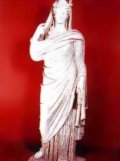THE
ARCHAEOLOGICAL
COLLECTION
OF
IERAPETRA
The Museum was founded at the end of the 19 th century, during the Turkish occupation, and after having changed many places is now housed at the building of the Commercial Ottoman School at Konoupaki square close to the Town Hall.
The Collection includes:
 Minoan Art.
Minoan Art.
The findings representative of this era all come from outside the area of the modern town.
The most important of these is a clay larnax (no. 822) which was found in Episkopi in the autumn of 1946 by professor N. Platon in a horse -shoe- shaped hewn tomb of the Late Minoan III period, which also contained two other larnakes.
Geometric Art.
There is very little to represent geometric art in the collection, due to the fact that there are really very few geometric sites in the district. The finds are mostly figurines and vases from 9 th to 8 th century B.C.
Archaic Art.
There are also not many exhibits of Archaic art. Mostly figurines and terracota votive plaques in relief.
Despite the introduction of mass production one can immediately see, in the forms of the period, that a great step forward in the handling of the modeling of small figurines has taken place since the previous period; this is the beginning of the later remarkable development of the plastic arts.
Classical and Hellenistic Art.
These two periods are presented together, because on the one hand Doric Hierapytna developed and came to the fore in the region apart from the direct political and cultural influences which were affecting the rest of the Helladic world outside of Crete, and on the other hand these finds have not been properly evaluated yet, although they constitute an important part of the collection.
Most of these exhibits, figurines and vases, come from ancient Hierapytna.

Red figure amphora no.522
The warrior's fare well
The red figure amphora no. 522 found at Manoliana, is very well preserved and, in addition to the floral motifs decorating the neck, has interesting scenes on both sides of the body.

Plastic vase no.280
A grotesque representation of an old man.
Graeco- Roman Art.

The term Graeco- Roman is applied to the work of local artists and craftsmen under the influence of the Romans. A series of lamps shows less the form than the favorite motifs for decorating the discus.
Sculpture- Statues
A large number of statues has been recovered from the Viglia area where the ancient city was situated. Most of them, of the Roman period are headless. There are life-size statues and statuettes and larger than life-size pieces.
Inscriptions
Inscriptions are perhaps the most important source of knowledge about ancient times, as they are a direct contemporary testimony of events; from them we learn so many details about the history, language, public affairs and private life in each region.

The inscription of the honorary decree of Klaudios Aristagoras
Today in the collection there are only two of the many important treaties of the multi- dimensional policies of the Hierapytnians. One of them records the alliance of the Hierapytnians with Antigonos of Macedonia, and the second the treaty of equality of civil rights with the Arcadians.
There are also two honorary decrees of interest. One of them is no 53, which was set up to record the honor done by the city to Titos Claudios Aristagoras, naming him a patron and protector.
Coins
As an autonomous state Hierapytna struck many different coins from which examples from 44 issues have been found; the majority are silver and some are real masterpieces of coin engraving.
USEFUL INFORMATION
telephone : +30 28420 28721
In and around
Show All
Tourism facilities
Regional interest
Towns & Villages
Sightseeing
Beaches